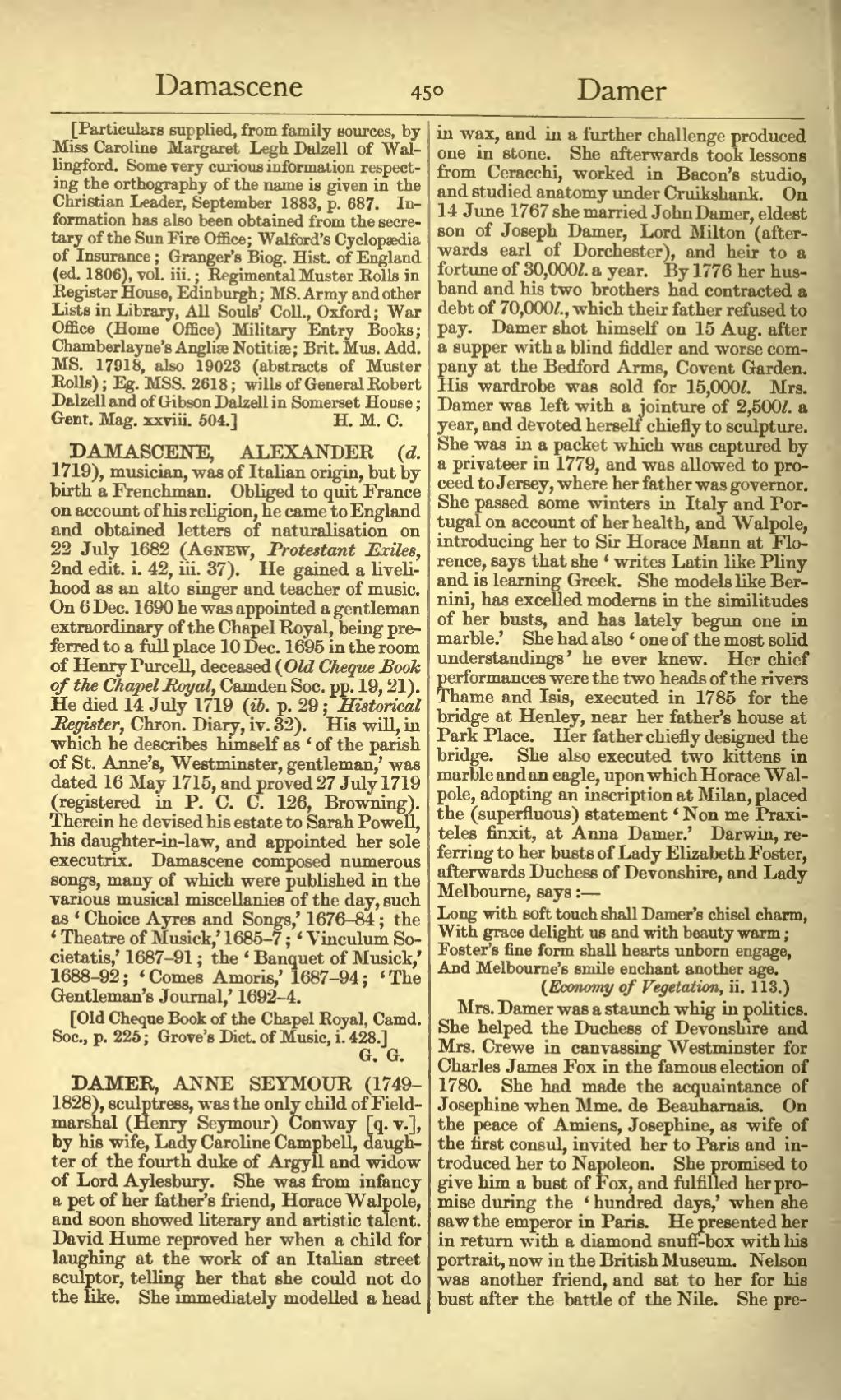[Particulars supplied, from family sources, by Miss Caroline Margaret Legh Dalzell of Wallingford. Some very curious information respecting the orthography of the name is given in the Christian Leader, September 1883, p. 687. Information has also been obtained from the secretary of the Sun Fire Office; Walford's Cyclopædia of Insurance; Granger's Biog. Hist. of England (ed. 1806), vol. iii.; Regimental Muster Rolls in Register House, Edinburgh; MS. Army and other Lists in Library, All Souls' Coll., Oxford; War Office (Home Office) Military Entry Books; Chamberlayne's Angliæ Notitiæ; Brit. Mus. Add. MS. 17918, also 19023 (abstracts of Muster Rolls); Eg. MSS. 2618; wills of General Robert Dalzell and of Gibson Dalzell in Somerset House; Gent. Mag. xxviii. 504.]
DAMASCENE, ALEXANDER (d. 1719), musician, was of Italian origin, but by birth a Frenchman. Obliged to quit France on account of his religion, he came to England and obtained letters of naturalisation on 22 July 1682 (Agnew, Protestant Exiles, 2nd edit. i. 42, iii. 37). He gained a livelihood as an alto singer and teacher of music. On 6 Dec. 1690 he was appointed a gentleman extraordinary of the Chapel Royal, being preferred to a full place 10 Dec. 1695 in the room of Henry Purcell, deceased (Old Cheque Book of the Chapel Royal, Camden Soc. pp. 19, 21). He died 14 July 1719 (ib. p. 29; Historical Register, Chron. Diary, iv. 32). His will, in which he describes himself as ‘of the parish of St. Anne's, Westminster, gentleman,’ was dated 16 May 1715, and proved 27 July 1719 (registered in P. C. C. 126, Browning). Therein he devised his estate to Sarah Powell, his daughter-in-law, and appointed her sole executrix. Damascene composed numerous songs, many of which were published in the various musical miscellanies of the day, such as ‘Choice Ayres and Songs,’ 1676–84; the ‘Theatre of Musick,’ 1685–7; ‘Vinculum Societatis,’ 1687–91; the ‘Banquet of Musick,’ 1688–92; ‘Comes Amoris,’ 1687–94; ‘The Gentleman's Journal,’ 1692–4.
[Old Cheque Book of the Chapel Royal, Camd. Soc., p. 225; Grove's Dict. of Music, i. 428.]
DAMER, ANNE SEYMOUR (1749–1828), sculptress, was the only child of Fieldmarshal (Henry Seymour) Conway [q. v.], by his wife, Lady Caroline Campbell, daughter of the fourth duke of Argyll and widow of Lord Aylesbury. She was from infancy a pet of her father's friend, Horace Walpole, and soon showed literary and artistic talent. David Hume reproved her when a child for laughing at the work of an Italian street sculptor, telling her that she could not do the like. She immediately modelled a head in wax, and in a further challenge produced one in stone. She afterwards took lessons from Ceracchi, worked in Bacon's studio, and studied anatomy under Cruikshank. On 14 June 1767 she married John Damer, eldest son of Joseph Damer, Lord Milton (afterwards earl of Dorchester), and heir to a fortune of 30,000l. a year. By 1776 her husband and his two brothers had contracted a debt of 70,000l., which their father refused to pay. Damer shot himself on 15 Aug. after a supper with a blind fiddler and worse company at the Bedford Arms, Covent Garden. His wardrobe was sold for 15,000l. Mrs. Damer was left with a jointure of 2,500l. a year, and devoted herself chiefly to sculpture. She was in a packet which was captured by a privateer in 1779, and was allowed to proceed to Jersey, where her father was governor. She passed some winters in Italy and Portugal on account of her health, and Walpole, introducing her to Sir Horace Mann at Florence, says that she ‘writes Latin like Pliny and is learning Greek. She models like Bernini, has excelled moderns in the similitudes of her busts, and has lately begun one in marble.’ She had also ‘one of the most solid understandings’ he ever knew. Her chief performances were the two heads of the rivers Thame and Isis, executed in 1785 for the bridge at Henley, near her father's house at Park Place. Her father chiefly designed the bridge. She also executed two kittens in marble and an eagle, upon which Horace Walpole, adopting an inscription at Milan, placed the (superfluous) statement ‘Non me Praxiteles finxit, at Anna Damer.’ Darwin, referring to her busts of Lady Elizabeth Foster, afterwards Duchess of Devonshire, and Lady Melbourne, says:—
Long with soft touch shall Damer's chisel charm,
With grace delight us and with beauty warm;
Foster's fine form shall hearts unborn engage,
And Melbourne's smile enchant another age.
(Economy of Vegetation, ii. 113.)
Mrs. Damer was a staunch whig in politics. She helped the Duchess of Devonshire and Mrs. Crewe in canvassing Westminster for Charles James Fox in the famous election of 1780. She had made the acquaintance of Josephine when Mme. de Beauharnais. On the peace of Amiens, Josephine, as wife of the first consul, invited her to Paris and introduced her to Napoleon. She promised to give him a bust of Fox, and fulfilled her promise during the ‘hundred days,’ when she saw the emperor in Paris. He presented her in return with a diamond snuff-box with his portrait, now in the British Museum. Nelson was another friend, and sat to her for his bust after the battle of the Nile. She pre-
